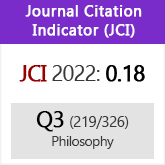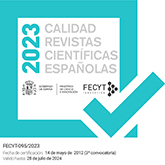Bruno Latour’s Realism: mummies, bacteria, and sciences war against postmodernity
DOI:
https://doi.org/10.3989/isegoria.2021.65.10Keywords:
Bruno Latour, Circulating reference, Construction of facts, Realism, ConstructivismAbstract
Bruno Latour have been included among the ranks of social constructivism since the 1990’s. In this paper, we analyze one of Latour’s most cited -and criticized- papers, in which he sustained that to say that Ramses II died because of tuberculosis was a nonsense, as ridiculous as to say the he died “of machine gun fire”. To do that, we will contextualize his text in its historical period of production, we will identify Latour’s ontological commitments, and we will introduce his theory on the construction of facts and what he calls circulating reference. We will conclude that Latour was right, neither Ramses II died because of tuberculosis, nor he is a social constructivist.
Downloads
References
Bartra, R. (2008). Relativismo relativista. Letras Libres. http://www.letraslibres.com/mexico-espana/relativismo-relativista
Bell, L. (1973). In the Tombs of the High Priest of Amun. Expedition, 15 (2), 17-25.
Blanco Merlo, J. R. (2001). Guerras de la ciencia, imposturas intelectuales y estudios de la ciencia. REIS: Revista Española de Investigaciones Sociológicas, 94, 129-152.
Bloor, D. (1991). Knowledge and Social Imagery (2nd ed.). University of Chicago Press.
Callon, M. (1999). Whose Imposture?: Physicists at War with the Third Person. Social Studies of Science, 29 (1), 261-286.
Campos Marín, R. (2003). Monlau, Rubio, Gine. Curar y gobernar: medicina y liberalismo en la España del siglo XIX. Nívola.
Daston, L. (2000). Biographies of Scientific Objects. University of Chicago Press.
Daston, L. (2009). Science Studies and the History of Science. Critical Inquiry, 35 (4), 798-813.
Derrida, J. (1997, noviembre 20). Sokal et Bricmont ne sont pas sérieux. Le Monde.fr. https://www.lemonde.fr/archives/article/1997/11/20/sokal-et-bricmont-ne-sont-pas-serieux_3804193_1819218.html
Edge, J. (2018, septiembre 26). Diagnosing the past. Wellcome Collection. https://wellcomecollection.org/articles/W5D4eR4AACIArLL8
Fakiner, N. (2016). The spatial rhetoric of Gustav Zeiller’s popular anatomical museum. Dynamis: Acta Hispanica ad Medicinae Scientiarumque Historiam Illustrandam, 36 (1), 47-72.
Fuller, S. (1994). Can Science Studies be Spoken in a Civil Tongue? Social Studies of Science, 24 (1), 143-168.
Galison, P. y Hevly, B. (1992). Big Science: Growth of Large-scale Research. Stanford Univ PR.
Gámez, L. A. (2016, noviembre 2). Aberraciones intelectuales. La Verdad. https://www.laverdad.es/murcia/culturas/201611/02/aberraciones-intelectuales-20161102004241-v.html
García Díaz, P. (2007). Bruno Latour y los límites de la descripción en el estudio de la ciencia. Editorial de la Universidad de Granada.
Gross, P. R. y Levitt, N. (1997). Higher Superstition: The Academic Left and Its Quarrels with Science. Johns Hopkins University Press.
Guillory, J. (2002). The Sokal Affair and the History of Criticism. Critical Inquiry, 28 (2), 470-508.
Harman, G. (2009). Prince of Networks: Bruno Latour and Metaphysics. re.press.
Jurdant, B. (ed.) (1998). Impostures scientifiques-Les malentendus de l’affaire Sokal. La Découverte.
Knorr-Cetina, K. D. y Mulkay, M. (1983). Science Observed: Perspectives on the Social Study of Science. SAGE Publications Ltd.
Kofman, A. (2018, octubre 25). Bruno Latour, the Post-Truth Philosopher, Mounts a Defense of Science. The New York Times. https://www.nytimes.com/2018/10/25/magazine/bruno-latour-post-truth-philosopher-science.html
Kuhn, T. S. (1962). The Structure of Scientific Revolutions. University of Chicago Press.
Latour, B. (1983). Give me a laboratory and I will move the world. En K.D. Knorr-Cetina, y M. Mulkay (ed.) Science Observed: Perspectives on the Social Study of Science. SAGE Publications Ltd.
Latour, B. (1988). A Relativistic Account of Einstein’s Relativity. Social Studies of Science, 18 (1), 3-44.
Latour, B. (1992). Ciencia en acción. Cómo seguir a los científicos e ingenieros a través de la sociedad. Labor.
Latour, B. (1993a). The Pasteurization of France (Edición: New Ed). Harvard University Press.
Latour, B. (1993b). We Have Never Been Modern (C. Porter, Trad.). Harvard University Press.
Latour, B. (2000). On the Partial Existence of Existing and Nonexisting Objects. En L. Daston (Ed.), Biographies of Scientific Objects. University of Chicago Press.
Latour, B. (2001). La esperanza de Pandora. Gedisa.
Latour, B. (2010). Crónicas de un amante de las ciencias. Dedalus Editores.
Latour, B. y Woolgar, S. (1986). Laboratory Life: The Construction of Scientific Facts (2nd ed.). Princeton University Press.
Llagostera, E. (2010). Viaje póstumo a París del Faraón Ramsés II. Espacio, tiempo y forma. Serie II, Historia antigua (23), 61-89.
Marie, M. (2020, mayo 14). Is Ramses II the Pharaoh of Moses? EgyptToday. http://www.egypttoday.com/Article/4/86762/Is-Ramses-II-the-Pharaoh-of-Moses
Mermin, N. D. (1997). What’s Wrong with This Reading. Physics Today, 50 (10), 11-13.
Quirantes, A. (2014, enero 10). Impostores y posmodernos, el caso Sokal. Naukas. https://naukas.com/2014/01/10/impostores-y-posmodernos-el-caso-sokal/
Searle, J. R. (2011). ¿Por qué creerlo? (L. Gago, Trad.). Revista de libros de la Fundación Caja Madrid, 170, 21-24. Disponible en JSTOR.
Sokal, A. D. (1996a). A Physicists Experiments with Cultural Studies. Lingua Franca, May/June. http://linguafranca.mirror.theinfo.org/9605/sokal.html
Sokal, A. D. (1996b). Transgressing the boundaries: Toward a transformative hermeneutics of quantum gravity. Social text, 46/47, 217-252.
Sokal, A. D. y Bricmont, J. (1999). Imposturas intelectuales. Ediciones Paidós Ibérica.
Weinberg, S. (1996, agosto 8). Sokal’s Hoax. The New York Review of Books, XLIII (13), 11-15.
Weinberg, S. (2010). El sueño de una teoría final: La búsqueda de las leyes fundamentales de la naturaleza. Booket.
Weinberg, S. (2012, mayo 10). The Crisis of Big Science. The New York Review.https://www.nybooks.com/articles/2012/05/10/crisis-big-science/
Zimmerman, M. R. (1979). Pulmonary and osseous tuberculosis in an Egyptian mummy. Bulletin of the New York Academy of Medicine, 55 (6), 604-608.
Published
How to Cite
Issue
Section
License
Copyright (c) 2021 Consejo Superior de Investigaciones Científicas (CSIC)

This work is licensed under a Creative Commons Attribution 4.0 International License.
© CSIC. Manuscripts published in both the printed and online versions of this Journal are the property of Consejo Superior de Investigaciones Científicas, and quoting this source is a requirement for any partial or full reproduction.All contents of this electronic edition, except where otherwise noted, are distributed under a “Creative Commons Attribution 4.0 International” (CC BY 4.0) License. You may read here the basic information and the legal text of the license. The indication of the CC BY 4.0 License must be expressly stated in this way when necessary.
Self-archiving in repositories, personal webpages or similar, of any version other than the published by the Editor, is not allowed.
Funding data
Ministerio de Ciencia e Innovación
Grant numbers PID2019-108988GB-I00
Universidad de Murcia
Grant numbers RG2020-004UM














